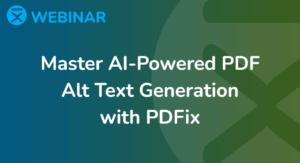Artificial Intelligence (AI) has been one of the most captivating and widely discussed technologies of the current decade, owing to its ability to mimic human intelligence. State-of-the-art AI services provide developing machines that can perceive, analyze, understand, and respond like humans. Even though document accessibility is currently mandatory in the public sector, additional progress is still necessary. The private sector faces a situation where companies provide millions of non-accessible PDFs and use them in business communication.
It’s all About Tags
Individuals with visual impairments use technology such as screen readers to navigate and read PDFs. However, this kind of technology requires additional information about the PDF’s logical structure presented in an understandable format. These logical structures can be added to a PDF using Tags. However, adding tags to the PDF manually is a difficult process that demands expertise, awareness, time, and costs.
An Impressive Progress with AI
PDF documents are universal and all-present, they hold plenty of valuable information that organizations and users benefit from. An organization-wide process and business imperative – PDF data extraction – is a difficult, time-consuming, and error-prone task, especially when dealing with large volumes of documents. Artificial intelligence (AI) makes impressive progress in this topic too, enabling the automation of PDF data extraction using machine learning algorithms.
An important contributor to this topic is the power of Natural Language Processing (NLP), which creates understanding by bridging the gap between human language and machine processing. Through the use of algorithms, NLP allows machines to analyze and interpret human language, which would otherwise be pretty difficult to understand.
Hence, in this time-sensitive situation resulting in possible legal action, organizations may turn to artificial intelligence as a means of speeding up this whole process. AI could be a viable solution in making documents accessible as machine learning algorithms are very good at recognizing certain patterns. The AI can identify structural components of text such as headings, subheadings, paragraphs, lists, and tables.
Use of External AI Modules
PDFix provides smooth integration with external document layout recognition AI modules.
Suppose you own a solution for table extraction, image alternative text description, reading order detection, or math formulas recognition. Our SDK smoothly converts obtained data back into PDF format and allows you to store your recognized structures in a standardized way to help you generate accessible PDFs.
Overall, converting extracted data back to a PDF is highly beneficial. It helps to improve document accessibility, integrity, and usefulness, making it easier to collaborate and share information with others. Eventually, it results in a more accessible and machine-readable document. One can then use it for a wide range of applications.
PDFix SDK API
It is important to mention PDFix SDK provides a quick and easy way to convert extracted data back to PDF in the form of tags. It allows you to either create an entirely new structure or edit already existing document tags.
Have a look at a few examples that use open-source AI models:
- Autotag a PDF With AI Model Deepdoctection
- Update Image Alternate Text in the PDF With AI Image Captioning
PDFix GitHub
Explore our Git Hub platform where we consistently deliver top-quality content and a collection of model code samples. We delightedly share here all our open-source codes for PDF-related tasks. Also, it covers our software development kit PDFix SDK which provides a set of tools and APIs for developers to create, manipulate, and extract data from PDF.
Please, feel free to follow the content here at PDFix GitHub, and let’s get going!



